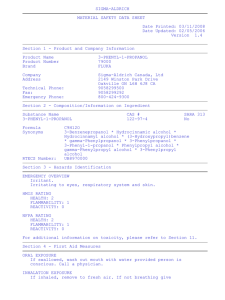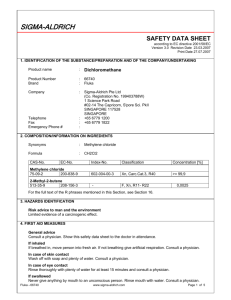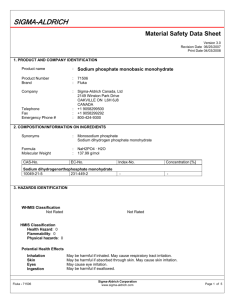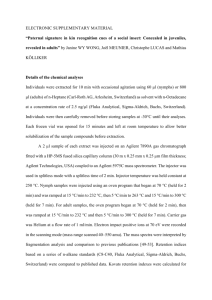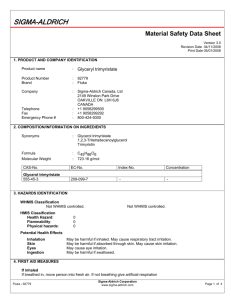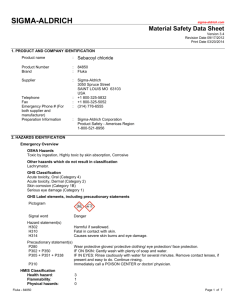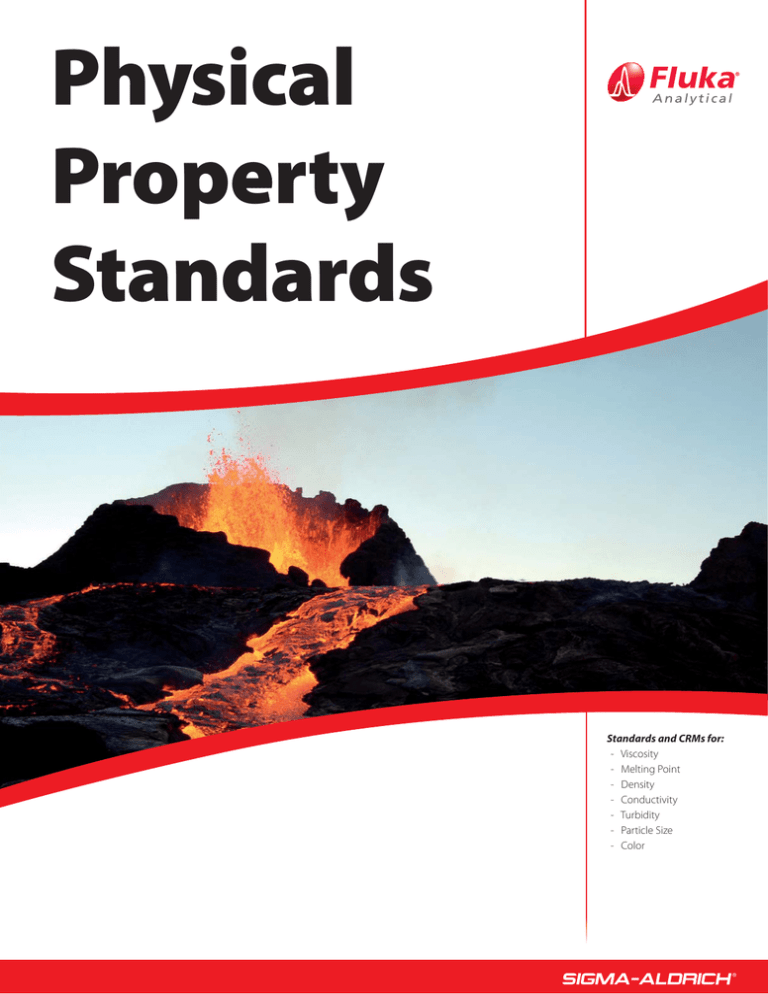
Physical
Property
Standards
Standards and CRMs for:
- Viscosity
- Melting Point
- Density
- Conductivity
- Turbidity
- Particle Size
- Color
There’s probably no laboratory in chemical research,
analytics or quality control that can do without measuring
physical properties. These complement the data of chemical
properties for the determination of the identity and purity
of substances and materials.
When a chemist is characterizing a substance that has been
synthesized, the melting point is surely one very important
specification. For the production process of bio diesel,
monitoring of the viscosity is absolutely crucial.
Conductivity measurements are an important tool in the
quality control of water. The particle size distribution of
starch is an important characteristic, which has influence in
its gelatinization and pasting properties, its baking
characteristics, cristallinity and swelling properties.
These are just a few simple examples to illustrate the huge
variety of applications where measurements of physical
properties are relevant.
The application fields range from pharmaceutical industry
through environmental analysis, food and beverage analysis,
forensics to material sciences.
To ensure the accuracy of these measurements, the
equipment needs to be regularly calibrated using accurate
analytical standards with known properties.
Sigma-Aldrich® offers a wide range of physical property
standards for various applications in the chemical, food and
material science industries. These include standards for
density, melting point, conductivity, viscosity, particle size,
turbidimetry as well as color reference standards.
Taking into account the growing need for certified reference
materials that are traceable to internationally accepted
reference materials such as NIST or BAM, we offer physical
property standards from recognized suppliers of high
quality Certified Reference Materials (CRMs) such as IRMM,
Whitehouse scientific, H&D Fitzgerald or Paragon Scientific.
This brochure gives an overview of the physical property
standards in the Sigma-Aldrich portfolio. We are
continuously expanding and complementing our product
portfolio, please consult the web for up to date information
about our portfolio: www.sigma-aldrich.com/standards
Table of Contents
Melting Point Standards
page 3
Cerified Density Standards
page 3
Conductivity Standards
page 3
Viscosity Standards
page 4
Turbidity Standards
page 5
Particle Size Standards
page 6
Color Reference Standards
page 7
Certified Physical Property Standards from the IRMM
page 9
sigma-aldrich.com/standards
Melting Point Standards
Table 1 Fluka-brand Melting Point Standards
Cat. No.
Melting point is used to identify compounds and estimate
purity. We offer a range of melting point standards to help
ensure reliable performance of melting point instruments.
Replicate measurements allow reporting of an uncertainty
value, +/- 0.3°C to +/- 0.5°C. Measurements are made in the
thermodynamic mode, with traceability to primary
reference material.
Brand Description
Package Size
76170
Fluka
Melting Point standard
121 – 123°C (Benzoic acid)
5g
42183
Fluka
Melting Point standard
182 – 184°C (p-Anisic acid)
250 mg, 1g
41019
Fluka
Melting Point standard
235 – 237°C (Caffeine)
1 g, 5g
67372
Fluka
Melting Point standard
283 – 286°C (Anthraquinone)
250 mg, 1g
50296
Fluka
Melting Point standard
47 – 49°C (Benzophenone)
1g, 5g
01422
Fluka
Melting Point standard
79 – 81°C (Naphthalene)
250 mg, 1g
Certified Density Standards from H&D Fitzgerald
Table 2 H&D Fitzgerald Density Standards
Cat. No.
Brand Description*
Package Size
44964
Fluka
Density Standard, 692 kg/m
76081
Fluka
Density Standard, 749 kg/m3
10 mL
76731
Fluka
Density Standard, 870 kg/m
3
10 mL
12156
Fluka
Density Standard, 998 kg/m3
10 mL
89353
Fluka
Density Standard, 1191 kg/m3
10 mL
36232
Fluka
Density Standard, 1251 kg/m
3
10 mL
15889
Fluka
Density Standard, 1623 kg/m3
10 mL
3
10 mL
* The precise density (at a given temperature) uncertainty is provided
with each sample. Density standards have an uncertainty of ±0.01 to
±0.03 kgm-3 over the stated temperature range.
Density standards are used to calibrate density meters.
Although calibration with air and water is common practice,
using reference standards has benefits with regard to GLP
compliance and traceability of the calibration to recognised
national standards. We offer a line of liquid density standards
from respected density metrologists H&D Fitzgerald. ISO
9001 and 17025 compliant, the standards are also supplied
with a UKAS-accredited calibration certificate, linking them
to recognized national standards of mass, temperature and
pressure. They are produced using a UKAS-accredited
hydrostatic weighing system, and supplied in 10 mL sealed
ampuls with a certificate of analysis.
Conductivity Standards
Table 3 Conductivity Standards
Cat. No.
Brand
Description
Package Size
11118
Fluka
Conductivity Standard
Solution, 50 mS/m
500 mL
60134
Fluka
Standard Solution A, acc.
to ISO 7888 (1290 mS/m)
250 mL
60136
Fluka
Standard Solution B, acc.
to ISO 7888 (141 mS/m)
250 mL
60138
Fluka
Standard Solution C, acc.
to ISO 7888 (14.7 mS/m)
250 mL
The electrical conductivity of aqueous solutions is a measure of
the current conducted by the ions present in the water. The
factors, that determine the conductivity are concentration and
nature of the ions as well as temperature and viscosity of the
solution. The electrical conductivity of pure water is 5.483 μS/m
at 25°C due to its own dissociation. The regulation ISO 7888
describes the use of electrical conductivity for monitoring the
quality of surface water, process water and waste water. We
offer three potassium chloride standard solutions according to
ISO 7888. The KCl concentrations of these solutions are 0.1M
(solution A), 0.01M (solution B) and 0.001M (solution C) and the
corresponding conductivities are 1290 mS/m, 141 mS/m and
14.7 mS/m. In addition, we offer a standard solution with a
conductivity of 50 mS/m (c(KCl) 0.0035 M)
sigma-aldrich.com/standards
Viscosity Standards from Paragon Scientific
Accurate viscosity measurements play an important role in
various fields of industry, such as food & beverage, paint &
coatings, pharmaceutical and petroleum. For the calibration
and verification of viscosity measuring equipment, analytical
standards with known viscosities are needed.
Sigma-Aldrich offers viscosity standards from Paragon
Scientific, that have been recently added to the Fluka
portfolio. These standards are produced in the United
Kingdom in an ISO 17025 certified laboratory. They are
manufactured in strict accordance with ASTM D 2162
(Standard Practice for basic calibration of master viscosity
standard oils) and are traceable to NIST. In the certificate, the
viscosity values and the density are stated at various
temperatures as well as expiry date and uncertainties. The
viscosity values are given as kinematic viscosity (mm2/s
(cSt)) and as dynamic viscosity (mPa’s (cP)) for all the
temperatures.
Table 4 Certified Viscosity and Density Standards from Paragon
Cat. No.
Brand
Description
Kinematic Viscosity
(mm2/s (cSt)) at 25°C
Dynamic Viscosity
(mPa‘s (cP)) at 25°C
Package Size
01446
Fluka
Viscosity and Density Standard N0.4
0.4583
0.3006
500 ML
67348
Fluka
Viscosity and Density Standard N0.8
0.6205
0.4329
500 ML
19044
Fluka
Viscosity and Density Standard N0.1
1.189
0.9184
500 ML
93835
Fluka
Viscosity and Density Standard N2
2.216
1.770
500 ML
41859
Fluka
Viscosity and Density Standard S3
4.014
3.251
500 ML
49571
Fluka
Viscosity and Density Standard D5
6.086
4.975
500 ML
05867
Fluka
Viscosity and Density Standard S6
8.792
7.237
500 ML
05854
Fluka
Viscosity and Density Standard D10
12.42
10.31
500 ML
63484
Fluka
Viscosity and Density Standard N10
17.01
14.43
500 ML
05428
Fluka
Viscosity and Density Standard S20
34.11
28.98
500 ML
18964
Fluka
Viscosity and Density Standard N35
65.07
55.43
500 ML
05397
Fluka
Viscosity and Density Standard S60
118.7
102.0
500 ML
05395
Fluka
Viscosity and Density Standard N100
238.3
206.0
500 ML
01437
Fluka
Viscosity and Density Standard S200
456.2
396.2
500 ML
69443
Fluka
Viscosity and Density Standard D500
578.1
502.5
500 ML
04870
Fluka
Viscosity and Density Standard N350
851.2
740.3
500 ML
08670
Fluka
Viscosity and Density Standard D1000
1159
1010
500 ML
08577
Fluka
Viscosity and Density Standard S600
1460
1277
500 ML
19495
Fluka
Viscosity and Density Standard N1000
2981
2618
500 ML
38177
Fluka
Viscosity and Density Standard S2000
5267
4638
500 ML
73284
Fluka
Viscosity and Density Standard D5000
5644
4975
500 ML
11492
Fluka
Viscosity and Density Standard D7500
8702
7686
500 ML
09216
Fluka
Viscosity and Density Standard N4000
11627
10296
500 ML
50989
Fluka
Viscosity and Density Standard S8000
22553
20032
500 ML
13219
Fluka
Viscosity and Density Standard N15000
44855
40006
500 ML
41272
Fluka
Viscosity and Density Standard S30000
79747
71382
500 ML
sigma-aldrich.com/standards
Turbidity Standards
The measurement of turbidity is an important method in water
quality testing. Turbidity can be defined as a decrease in the
transparency of a solution due to the presence of suspended
and dissolved substances, which causes incident light to be
scattered, reflected, and attenuated rather than transmitted in
straight lines; the higher the intensity of the scattered or
attenuated light, the higher the value of turbidity. Simply stated,
turbidity is the measure of relative sample clarity. Turbidity can be
expressed in nephelometric turbidity units (NTU).
The standards are delivered in quantities of 15 ml in vials made
out of optical glass. These vials are suitable for measurements
directly in the AQUANAL-plus Spectro Turbidity instrument.
Therefore the standards can be used as they are without any
decanting or dilution. They can also be used for any other
turbidity measurement instrument, although decanting into a
suitable cuvette might be necessary depending on the
instrument type.
The AQUANAL®-plus Spectro Turbidity (cat. No 70034) is
designed as a compact, easy to use instrument to determine
turbidity fast and accurately in the range 0.1 – 2000 NTU. A
light emitting diode (LED) is used as the light source with a
photo detector positioned to detect light scattered by a
sample at 90°C to the incident beam.
The four secondary calibration standards delivered with the
device can be ordered in sets of 2 or 4 standards and can also
be used for any other turbidity measurement device.
Table 5 Turbidity Measurement Equipment and Standards
Cat. No.
Brand
Description
70034
Fluka
AQUANAL-plus Spectro Turbidity
70036
Fluka
Secondary turbidity standards: 1 and 10 NTU, 2 pcs
70037
Fluka
Secondary turbidity standards: 100 and 1000 NTU, 2 pcs
70110
Fluka
Secondary turbidity standards: 1, 10, 100 and 1000 NTU, 4 pcs
sigma-aldrich.com/standards
Certified Standards from Whitehouse Scientific
Polydisperse Particle Size Standards
size. For the certification of the glass particles, several
unambiguous primary methods such as microscopy,
sieving, sedimentation and Coulter counter were used. The
standards are delivered in Sets of 10 vials in quantities
suitable for any method of analysis without further
subdivision.
These NIST (National Institute of Standards and Technology
(USA)) and NPL (National Physical Laboratory (UK)) traceable
standards were commissioned by the Bureau of Certified
References (BCR) and are measured by a large international
team including the 20 top laboratories in the field of particle
Table 6 Polydisperse Particle Size Standards from Whitehouse Scientific
Cat. No.
Brand
Description
Package Size
51358
Fluka
Polydisperse Particle Standard 0.1 – 1μm
10 x 0.02 g
42459
Fluka
Polydisperse Particle Standard 1– 10μm
10 x 0.1 g
05724
Fluka
Polydisperse Particle Standard 3 – 30 μm
10 x 0.05 g
94078
Fluka
Polydisperse Particle Standard 3 – 30 μm
10 x 0.1 g
80847
Fluka
Polydisperse Particle Standard 10 – 100 μm
10 x 0.25 g
40579
Fluka
Polydisperse Particle Standard 10 – 100 μm
10 x 0.5 g
08718
Fluka
Polydisperse Particle Standard 10 – 100 μm
10 x 1 g
57563
Fluka
Polydisperse Particle Standard 50 – 350 μm
10 x 0.5g
78456
Fluka
Polydisperse Particle Standard 50 – 350 μm
10 x 2.5g
94773
Fluka
Polydisperse Particle Standard 150 – 650 μm
10 x 2.5 g
Sieve Calibration Standards
the sieve which is shaken either manually or mechanically,
until an equilibrium has reached and no more particles pass
the sieve.
The Sieve Calibration Standards from Whitehouse Scientific
offer a unique method of calibrating sieves with traceability
to NIST and NPL. The glass microspheres are delivered in
sets of single shot bottles in order to eliminate operatorsampling errors.
By weighing the sieve and the single shot bottle before and
after the calibration, the percentage of microspheres
passing the sieve can be calculated and the mean aperture
size of the sieve can thus be determined using the
calibration graph supplied with the test certificate.
The calibration requires only about 2 minutes following a
simple procedure: The glass microspheres are placed into
Table 7 Sieve Calibration Standards from Whitehouse Scientific
Cat. No.
Brand
Description
Mesh #
Calibration Range
Package Size
12655
Fluka
Sieve Standard 45 μm
325
42.0 – 50.8
5 x 1.0 g
49500
Fluka
Sieve Standard 63 μm
230
56.6 – 70.4
5 x 1.0 g
42696
Fluka
Sieve Standard 75 μm
200
67.1 – 82.8
5 x 1.0 g
61847
Fluka
Sieve Standard 106 μm
140
91.4 – 117
5 x 1.0 g
18867
Fluka
Sieve Standard 125 μm
120
112 – 139
5 x 1.0 g
75446
Fluka
Sieve Standard 150 μm
100
134 – 167
5 x 1.5 g
43390
Fluka
Sieve Standard 180 μm
80
161 – 199
5 x 1.5 g
41544
Fluka
Sieve Standard 250 μm
60
226 – 281
5 x 2.5 g
67246
Fluka
Sieve Standard 300 μm
50
270 – 333
5 x 2.5 g
78900
Fluka
Sieve Standard 500 μm
35
440 – 557
5 x 2.5 g
sigma-aldrich.com/standards
Color Reference Standards
As one of the most obvious characteristic of a material, the
appearance, especially the color, plays an important role as
a specification criteria in quality control. To ensure
reproducibility and comparability of this important property,
Sigma-Aldrich offers a series of color reference solutions for
liquids and for solids the new Sigma-Aldrich color chart.
Color Reference Solutions
Color reference solutions are used to measure the degree of
coloration of liquids in the red, yellow, green, blue and
brown color ranges as specified by the European
Pharmacopoeia (Ph. Eur.), United States Pharmacopoeia
(USP) and by federal institutes such as the American Society
for Testing and Materials (ASTM).
Sigma-Aldrich offers the most commonly used color
reference solutions according to Ph. Eur., USP and ASTM/
APHA. These solutions are used to estimate the color of a
liquid against established international and standardised
liquid color values. The two convenient package sizes, 2 mL
or 10 mL, are sealed in airtight ampules under argon. Each
set is supplied with a certificate of analysis with the
expiration date clearly indicated on the label.
Proper Use of Color Standards
The perception of color and similarities between colors
depends to a great extent on the viewing conditions and
quality of illumination. Determinations should be made
under diffuse, uniform illumination and conditions that
minimise shadows and non-spectral reflectance. Liquids
should be compared in matched color comparison tubes
against a white background. The colors of the standards
should be as close as possible to those of the samples when
quantifying color differences.
Color Reference Solutions acc. to Ph. Eur.
Ph. Eur. solutions are available as a complete set of 37
solutions, divided into five color series: red (R1-R7), greenishyellow (GY1-GY7), yellow (Y1-Y7), brownishyellow (BY1-BY7)
and brown (B1-B9). Each color series is also sold separately.
Table 8 Color Reference Solutions acc. to Ph. Eur.
Cat. No. Brand Description
Package Size
83952
Fluka
Color reference solutions
B, BY, Y, GY, R acc. to Ph. Eur.,
set
Set of 2 mL
ampuls
83951
Fluka
Color reference solutions
B acc. to Ph. Eur., set
Set of 2 mL
ampuls
86293
Fluka
Color reference solutions
BY acc. to Ph. Eur., set
Set of 2 mL
ampuls
83883
Fluka
Color reference solutions
Y acc. to Ph. Eur., set
Set of 2 mL
ampuls
82995
Fluka
Color reference solutions
GY acc. to Ph. Eur., set
Set of 2 mL
ampuls
87448
Fluka
Color reference solutions
R acc. to Ph. Eur., set
Set of 2 mL
ampuls
90232
Fluka
Color reference solutions
B, BY, Y, GY, R acc. to Ph. Eur.,
set
Set of 10 mL
ampuls
92936
Fluka
Color reference solutions
B acc. to Ph. Eur., set
Set of 10 mL
ampuls
72666
Fluka
Color reference solutions
BY acc. to Ph. Eur., set
Set of 10 mL
ampuls
83967
Fluka
Color reference solutions
Y acc. to Ph. Eur., set
Set of 10 mL
ampuls
90269
Fluka
Color reference solutions
GY acc. to Ph. Eur., set
Set of 10 mL
ampuls
95872
Fluka
Color reference solutions
R acc. to Ph. Eur., set
Set of 10 mL
ampuls
sigma-aldrich.com/standards
Color Reference Solutions acc. to USP
The USP prescribes twenty different color solutions, marked
A-T, covering the range red, yellow, green, blue and purple.
These solutions are available in one complete set.
Color Reference Solutions acc. to ASTM/APHA
ASTM lists a standard method for the visual measurement of
the color of light-colored liquids using the platinum-cobalt
scale. This method is referred to by many as APHA color. The
preparation of these platinum-cobalt standards was
originally described by A. Hazen. Consequently, this test is
also termed “Hazen Color.”The complete APHA set comprises
20 standard solutions, marked with different color standard
numbers: 5, 10, 15, 20, 25, 30, 35, 40, 50, 60, 70, 100, 150, 200,
250, 300, 350, 400, 450 and 500.
The Sigma-Aldrich Color Chart for Solids
With the Sigma-Aldrich Color Chart we now give our
customers a fast and uncomplicated tool to check and
compare the color of solids.
The Sigma-Aldrich Color Chart has been developed for
internal use in quality control of all the Sigma-Aldrich
production sites.
Table 9 Color Reference Solutions acc. to USP
Cat. No.
Brand Description
Package Size
87576
Fluka
Color reference solutions
acc. to USP, set
Set of 2 mL
ampuls
87574
Fluka
Color reference solutions
acc. to USP, set
Set of 10 mL
ampuls
Table 10 Color Reference Solutions acc. to ASTM/APHA
Cat. No. Brand Description
Package Size
72599
Fluka
Color reference solutions
acc. to APHA, set
Set of 2 mL
ampuls
77147
Fluka
Color reference solutions
acc. to APHA, set
Set of 10 mL
ampuls
large number of colors is much too big to handle in daily
practice during practical tests we identified the colors most
frequently occurring in our products, which colors most often
caused problems in the color communication and with
which colors we most frequently had to use paraphrases to
explain the color.
Table 11 Color Chart for Solids
Cat. No.
Brand
91711
Fluka
Description
Sigma-Aldrich Color Chart
Considering our huge portfolio of different chemical
products, the common color system should bring clarity in
the jungle of colors and be simple to apply in the daily
practice. Furthermore it should be based upon an accepted
color system; communicable, reproducible and applicable
everywhere.
Many color order systems use a quasi-spherical color space, in
which the position of each color is described with three
coordinates. We chose the Munsell color order system, which
fulfilled all our needs. Therein each color is identified by the
attributes of hue, value and chroma.
The Munsell Books of Color contains thousands of color chips
which are defined according to the Munsell color system. This
sigma-aldrich.com/standards
The result is a selection of colors from the Munsell color
order system; this selection contains 51 color chips. These
chips are applied to a white background on one page. No
turning of pages is necessary, which facilitates and speeds
up the daily use of the color chart. Below the color chips you
find the short-code plus the internally defined color name.
On the other page there is a table from which you can see
the hue, value and chroma for each of the colors according
to the Munsell system.
Certified Physical Property Standards from the IRMM
The IRMM (Institute of Reference Materials and
Measurements), founded in 1957 and situated in Geel
(Belgium), is one of the seven institutes of the Joint Research
Center, a Directorate-General of the European commission.
The mission of IRMM is to promote a common and reliable
European measurement system in support of EU policies.
Certified Materials for Mechanical Properties
The European Federation of Chemical Engineering (EFCE)
developed a test method to determine the shear strength of
powders under different compaction and loading conditions.
Product BCR-116 is a limestone powder certified in accordance
with this test.
As a part of this, the IRMM supplies certified reference
materials (pure and matrix materials) for various applications
including environmental analysis, food analysis, clinical
chemistry, physical properties or industrial applications.
Creep is the progressive deformation of a material under load.
The certified material BCR-425 has been developed for the
validation of creep testing rigs and procedures.
As an official distributor, Sigma-Aldrich offers all the IRMM
certified reference materials including about 80 CRMs for
physical properties.
BCR-692 is intended to use for the verification of the overall
performance of scratch test instruments.
Table 13 Certified Materials for Mechanical Properties
Cat. No.
A complete listing of physical property standards from the
IRMM can be found on our website at:
www.sigmaaldrich.com/physicalproperties_irmm
On the page www.sigmaaldrich.com/irmm you will find a
link to the complete IRMM catalogue as well as a link to the
IRMM online catalogue where certificates and reports to all
the products are directly accessible.
In the following tables, we give an overview on the products
and product classes of reference materials for thermal,
mechanical, morphological and optical properties as well as for
certified reference materials for isotopic measurements .
Certified Materials for Thermal Properties
Thermal conductivity (λ) is the ability of a material to conduct
heat. It is one of the fundamental material characteristics
governing heat transport in industrial processes.
Description
Certified for
BCR-116
Limestone Powder
Shear testing
BCR-425
Nickel-based alloy
Creep testing
BCR-692
Diamond-like-carbon
coated steel
Scratch testing
The Charpy pendulum impact test is designed to assess the
resistance of a material to shock loading, by breaking a
notched bar using a hammer rotating around a fixed
horizontal axis. Because the energy absorbed by the test
sample depends very much on the construction of the
pendulum, reference test pieces are required. The certified
test bars from ERM are delivered in packages with 5 pieces.
Table 14 Reference materials for mechanical properties
(Charpy specimen)
Table 12 Certified Materials for Thermal Properties
Cat. No.
Description
IRMM440A
IRMM440B
IRMM440C
IRMM440D
Resin bonded glass fiber
board
BCR724A
BCR724B
BCR724C
BCR724D
BCR724E
Glass Ceramic
BCR-039
Pyrex Glass
Cat. No.
Description
Certified for
Certified for
ERM-FA013
Charpy specimen
Impact toughness (30 J)
Thermal
Conductivity
ERM-FA014
Charpy specimen
Impact toughness (60 J)
ERM-FA015
Charpy specimen
Impact toughness (80 J)
ERM-FA016
Charpy specimen
Impact toughness (120 J)
ERM-FA415
Charpy specimen
Impact toughness (150 J)
Thermal
Conductivity
Thermal
Conductivity
sigma-aldrich.com/standards
Certified Materials for Morphological Properties
The IRMM supplies several particle size standards certified for
Stokes diameter or volume diameter respectively, as well as
certified reference material for specific surface area. The
corresponding product numbers are listed in the table below.
Table 15 Certified Materials for Morphological Properties
Cat. No.
Description
Certified for
BCR-066
Quartz 0.35-3.50 μm
Stokes’ diameter
BCR-067
Quartz 2.40-32.00 μm
Stokes’ diameter
BCR-069
Quartz 14-90 μm
Stokes’ diameter
BCR-070
Quartz 1.20-20.00μm
Stokes’ diameter
BCR-068
Quartz 160-630 μm
Volume diameter
BCR-130
Quartz 50-220 μm
Volume diameter
BCR-131
Quartz 480-1800 μm
Volume diameter
BCR-132
Quartz 1400-5000 μm
Volume diameter
BCR-169
Alpha Alumina
Specific Surface area
BCR-170
Alpha Alumina
Specific Surface area
BCR-171
Alumina
Specific Surface area
BCR-172
Quartz
Specific Surface area
BCR-173
Tutanium Dioxide
Specific Surface area
BCR-175
Tungsten
Specific Surface area
For measurements of compositional depth profiles using
ion beam sputtering in association with Auger Electron
Spectroscopy, a reference material of known thickness is
required. BCR-261T is a tantalum pentoxide on tantalum foil
reference materials with two nominal thicknesses (30 nm
and 100 nm) available as four rectangular foils for each oxide
thickness.
BCR-301, certified for lattice spacing is intended for the use
as standard in X-ray diffraction analysis.
The microcrystalline cellulose reference material BCR-302
has been developed to check the implementation of the
water sorption method recommended by the COST 90, a
procedure for the determination of water sorptions
sigma-aldrich.com/standards
isotherms in foods. The material is certified for its water
content when in equilibrium with the atmosphere above 10
specified salt solution at 25°C.
The recently added IRMM-304 is not a CRM but an example
of a QCM (quality control material) for morphological
properties. It consists of silica nanoparticles, suspended in
an aqueous solution and its intended use is to check the
performance of instruments or methods that characterize
the particle size distribution of nanoparticles suspended in
a liquid medium.
Since silicon oxide/silicon interface characteristics gain
more and more importance, reference materials of silicon
dioxide layers of defined thicknesses on silicon wafers are
needed. With the certified reference material BCR-564 we
offer such a reference material intended to be used as
calibration standards for ellipsometry (Set of three standards,
1 standard each for 10, 50 and 120 nm SiO2 on silicon wafer).
Products BCR-704 and BCR-705 are certified for micropore
volume and median micropore width. Their intended use is
to test the accuracy and the effectiveness of instruments for
pore size analysis based on gas adsorption.
Table 16 Certified Materials for Morphological Properties
Cat. No.
Description
Certified for
BCR-261T
Tantalum Pentoxide
Depth profiling by ion
beam sputtering
BCR-301
Mullite
Lattice spacing
BCR-302
Microcrystalline
Cellulose
Water Sorption
IRMM-304
Colloidal Silica
(suspension)
Particle Size Distribution
BCR-564
Silicon
Thickness of Silicon
Dioxide
BCR-704
Faujasite type zeolite
Micropore volume /
median micropore width
BCR-705
Linde type A zeolite
Micropore volume /
median micropore width
Certified Materials for Optical Properties
Certified reference material BCR-400 consists of a ceramic
tile with a color typical of that required by the tomato
processing industry. The material is intended to be used for
calibration of a tristimilus colorimeter.
BCR-406A is a reference material for colorimeters and
spectrophotometers measuring color in reflection.
Table 17 Reference Materials for Optical Properties
Cat. No.
BCR-400
BCR-406A
Description
Tomato paste color tile
Opal glass
Certified for
Hunter L, a, b Values
Spectral Reflectance
Certified Reference Materials for Isotopic Measurements
There are two types of materials related to isotopic
measurements: Materials that are certified for the isotope
abundance ratio and materials, that are certified for the
isotope amount content. The former are suitable for
calibration of measurements of isotope abundance ratios.
The latter can be directly used in isotope dilution as “spikes”
against which an unknown amount of an isotope or an
element can be measured.
Table 18 Reference materials for Isotopic Measurements
Cat. No.
IRMM-011
Description
H3BO3
Isotope abundance ratio
Ca in 0.6M HNO3
Isotope abundance ratio
Cr in 1M HCl
Isotope abundance ratio
ERM-AE701
41
IRMM-012
52
IRMM-014a
Certified for
Fe nat cubes
Isotope abundance ratio
IRMM-014b
Fe nat wire
Isotope abundance ratio
IRMM-015
6
Li (Li2CO3)
Isotope abundance ratio
IRMM-016
7
Li (Li2CO3)
Isotope abundance ratio
IRMM-009
24
Mg in 0.2M HNO3
Isotope abundance ratio
IRMM-010
Pt isotopic wire
Isotope abundance ratio
IRMM-017
Si single crystal
Isotope abundance ratio
IRMM-018a
28
Si (SiO2)
Isotope amount content
IRMM-610
10
B aqueous solution
Isotope amount content
IRMM-611
11
B aqueous solution
Isotope amount content
IRMM-621
111
Cd in 1M HNO3
Isotope amount content
IRMM-622
111
Cd in 1M HNO3
Isotope amount content
ERM-AE641
35
Cl in water
Isotope amount content
ERM-AE642
37
Cl in water
Isotope amount content
IRMM-624
50
Cr in 1M HCl
Isotope amount content
IRMM-625
51
Cr in 1M HCl
Isotope amount content
IRMM-632
65
Cu in 1M HNO3
Isotope amount content
ERM-AE633
63
Cu in 1M HNO3
Isotope amount content
ERM-AE647
63
Cu in 1M HNO3
Isotope amount content
IRMM-620
57
Fe in 4.5M HCl
Isotope amount content
IRMM-634
56
Fe in 1.8M HCl
Isotope amount content
ERM-AE639
202
Hg in 0.5M HCl
Isotope amount content
ERM-AE640
202
Hg in 0.5M HCl
Isotope amount content
IRMM-615
6
ERM-AE637
ERM-AE638
Li in 0.5M HCl
Isotope amount content
24
Mg in 0.2M HNO3
Isotope amount content
26
Mg in 0.1M HNO3
Isotope amount content
IRMM-618
87
Rb in 0.5M HNO3
Isotope amount content
IRMM-619
85
Rb in 0.5M HNO3
Isotope amount content
IRMM-643
32
S in 2.8M HNO3
Isotope amount content
IRMM-644
32
S in 3.2M HNO3
Isotope amount content
IRMM-645
32
S in 2.8M HNO3
Isotope amount content
IRMM-646
34
S in 2.8M HNO3
Isotope amount content
IRMM-635
84
Sr in 1M HNO3
Isotope amount content
ERM-AE649
205
Tl in 1M HNO3
Isotope amount content
IRMM-007
64
Zn in 0.5M HNO3
Isotope amount content
IRMM-651
64
Zn in 0.5M HNO3
Isotope amount content
IRMM-652
64
Zn in 0.5M HNO3
Isotope amount content
IRMM-653
67
Zn in 0.5M HNO3
Isotope amount content
IRMM-654
68
Zn in 0.5M HNO3
Isotope amount content
IRMM-3702
64
Zn in 1M HNO3
Isotope amount content
sigma-aldrich.com/standards
Slovakia
SIGMA-ALDRICH spol. s r.o.
Tel: (+421) 255 571 562
Fax: (+421) 255 571 564
Argentina
SIGMA-ALDRICH DE ARGENTINA S.A.
Free Tel: 0810 888 7446
Tel: (+54) 11 4556 1472
Fax: (+54) 11 4552 1698
France
SIGMA-ALDRICH CHIMIE S.à.r.l.
Free Tel: 0800 211 408
Free Fax: 0800 031 052
Tel: (+33) 474 82 28 00
Fax: (+33) 474 95 68 08
Korea
SIGMA-ALDRICH KOREA
Free Tel: (+82) 80 023 7111
Free Fax: (+82) 80 023 8111
Tel: (+82) 31 329 9000
Fax: (+82) 31 329 9090
Australia
SIGMA-ALDRICH PTY LTD.
Free Tel: 1800 800 097
Free Fax: 1800 800 096
Tel: (+61) 2 9841 0555
Fax: (+61) 2 9841 0500
Germany
SIGMA-ALDRICH CHEMIE GmbH
Free Tel: 0800 51 55 000
Free Fax: 0800 64 90 000
Tel: (+49) 89 6513 0
Fax: (+49) 89 6513 1160
Malaysia
SIGMA-ALDRICH (M) SDN. BHD
Tel: (+60) 3 5635 3321
Fax: (+60) 3 5635 4116
South Africa
SIGMA-ALDRICH
SOUTH AFRICA (PTY) LTD.
Free Tel: 0800 1100 75
Free Fax: 0800 1100 79
Tel: (+27) 11 979 1188
Fax: (+27) 11 979 1119
Austria
SIGMA-ALDRICH HANDELS GmbH
Tel: (+43) 1 605 81 10
Fax: (+43) 1 605 81 20
Greece
SIGMA-ALDRICH (O.M.) LTD.
Tel: (+30) 210 994 8010
Fax: (+30) 210 994 3831
Mexico
SIGMA-ALDRICH QUÍMICA, S.A. de C.V.
Free Tel: 01 800 007 5300
Free Fax: 01 800 712 9920
Tel: 52 722 276 1600
Fax: 52 722 276 1601
Spain
SIGMA-ALDRICH QUÍMICA, S.A.
Free Tel: 900 101 376
Free Fax: 900 102 028
Tel: (+34) 91 661 99 77
Fax: (+34) 91 661 96 42
Belgium
SIGMA-ALDRICH NV/SA.
Free Tel: 0800 14747
Free Fax: 0800 14745
Tel: (+32) 3 899 13 01
Fax: (+32) 3 899 13 11
Hungary
SIGMA-ALDRICH Kft
Ingyenes zöld telefon: 06 80 355 355
Ingyenes zöld fax: 06 80 344 344
Tel: (+36) 1 235 9055
Fax: (+36) 1 235 9050
India
SIGMA-ALDRICH CHEMICALS
PRIVATE LIMITED
Telephone
Bangalore: (+91) 80 6621 9600
New Delhi: (+91) 11 4165 4255
Mumbai: (+91) 22 2570 2364
Hyderabad: (+91) 40 4015 5488
Fax
Bangalore: (+91) 80 6621 9650
New Delhi: (+91) 11 4165 4266
Mumbai: (+91) 22 2579 7589
Hyderabad: (+91) 40 4015 5466
Brazil
SIGMA-ALDRICH BRASIL LTDA.
Free Tel: 0800 701 7425
Tel: (+55) 11 3732 3100
Fax: (+55) 11 5522 9895
Canada
SIGMA-ALDRICH CANADA LTD.
Free Tel: 1800 565 1400
Free Fax: 1800 265 3858
Tel: (+1) 905 829 9500
Fax: (+1) 905 829 9292
Ireland
SIGMA-ALDRICH IRELAND LTD.
Free Tel: 1800 200 888
Free Fax: 1800 600 222
Tel: (+353) 1 404 1900
Fax: (+353) 1 404 1910
China
SIGMA-ALDRICH (SHANGHAI)
TRADING CO. LTD.
Free Tel: 800 819 3336
Tel: (+86) 21 6141 5566
Fax: (+86) 21 6141 5567
The Netherlands
SIGMA-ALDRICH CHEMIE BV
Free Tel: 0800 022 9088
Free Fax: 0800 022 9089
Tel: (+31) 78 620 5411
Fax: (+31) 78 620 5421
New Zealand
SIGMA-ALDRICH NEW ZEALAND LTD.
Free Tel: 0800 936 666
Free Fax: 0800 937 777
Tel: (+61) 2 9841 0555
Fax: (+61) 2 9841 0500
Norway
SIGMA-ALDRICH NORWAY AS
Tel: (+47) 23 17 60 60
Fax: (+47) 23 17 60 50
Poland
SIGMA-ALDRICH Sp. z o.o.
Tel: (+48) 61 829 01 00
Fax: (+48) 61 829 01 20
Portugal
SIGMA-ALDRICH QUÍMICA, S.A.
Free Tel: 800 202 180
Free Fax: 800 202 178
Tel: (+351) 21 924 2555
Fax: (+351) 21 924 2610
Czech Republic
SIGMA-ALDRICH spol. s r. o.
Tel: (+420) 246 003 200
Fax: (+420) 246 003 291
Israel
SIGMA-ALDRICH ISRAEL LTD.
Free Tel: 1 800 70 2222
Tel: (+972) 8 948 4100
Fax: (+972) 8 948 4200
Denmark
SIGMA-ALDRICH DENMARK A/S
Tel: (+45) 43 56 59 10
Fax: (+45) 43 56 59 05
Italy
SIGMA-ALDRICH S.r.l.
Numero Verde: 800 827018
Tel: (+39) 02 3341 7310
Fax: (+39) 02 3801 0737
Russia
SIGMA-ALDRICH RUS, LLC
Tel: +7 (495) 621 6037
+7 (495) 621 5828
Fax: +7 (495) 621 5923
Finland
SIGMA-ALDRICH FINLAND OY
Tel: (+358) 9 350 9250
Fax: (+358) 9 350 92555
Japan
SIGMA-ALDRICH JAPAN K.K.
Tel: (+81) 3 5796 7300
Fax: (+81) 3 5796 7315
Singapore
SIGMA-ALDRICH PTE. LTD.
Tel: (+65) 6779 1200
Fax: (+65) 6779 1822
World Headquarters
Order/Customer Service (800) 325-3010 t Fax (800) 325-5052
3050 Spruce St., St. Louis, MO 63103
(314) 771-5765
sigma-aldrich.com
Technical Service (800) 325-5832 t sigma-aldrich.com/techservice
Development/Bulk Manufacturing Inquiries
(800) 244-1173
© 2009 Sigma-Aldrich Co. All rights reserved. SIGMA,
, SAFC,
, SIGMA-ALDRICH, ALDRICH,
, FLUKA, , and SUPELCO,
are trademarks belonging to Sigma-Aldrich
Co. and its affiliate Sigma-Aldrich Biotechnology, L.P. Sigma brand products are sold through Sigma-Aldrich, Inc. Sigma-Aldrich, Inc. warrants that its products conform to the
information contained in this and other Sigma-Aldrich publications. Purchaser must determine the suitability of the product(s) for their particular use. Additional terms and conditions
may apply. Please see reverse side of the invoice or packing slip.
Date:
Date:10/2009
10/2009;
SAMS
SAMSCode:
Code:LPD
LDZ
sigma-aldrich.com/standards
Sweden
SIGMA-ALDRICH SWEDEN AB
Tel: (+46) 8 742 4200
Fax: (+46) 8 742 4243
Switzerland
SIGMA-ALDRICH CHEMIE GmbH
Free Tel: 0800 80 00 80
Free Fax: 0800 80 00 81
Tel: (+41) 81 755 2828
Fax: (+41) 81 755 2815
United Kingdom
SIGMA-ALDRICH COMPANY LTD.
Free Tel: 0800 717 181
Free Fax: 0800 378 785
Tel: (+44) 1747 833 000
Fax: (+44) 1747 833 313
SAFC (UK) Free Tel: 01202 712305
United States
SIGMA-ALDRICH
P.O. Box 14508
St. Louis, Missouri 63178
Toll-Free: 800 325 3010
Toll-Free Fax: 800 325 5052
Call Collect: (+1) 314 771 5750
Tel: (+1) 314 771 5765
Fax: (+1) 314 771 5757
Vietnam
SIGMA-ALDRICH Pte Ltd. VN R.O.
133/27N Ngo Duc Ke Street,
Ward 12 Binh Thanh District,
Ho Chi Minh City
P: (848) 3516 2810
F: (848) 6258 4238
Internet
sigma-aldrich.com
Accelerating Customers’
Success through Leadership
in Life Science, High
Technology and Service

